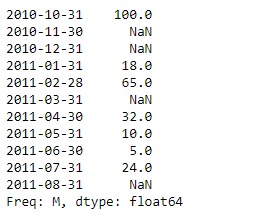Pandas 系列是带有轴标签的一维ndarray。标签不必是唯一的,但必须是可哈希的类型。该对象同时支持基于整数和基于标签的索引,并提供了许多方法来执行涉及索引的操作。
Pandas Series.count()函数返回的计数non-NA/null给定Series对象中的观测值。
用法: Series.count(level=None)
参数:
level:如果轴是MultiIndex(分层),则沿特定级别计数,折叠为较小的Series
返回:nobs:int或Series(如果指定级别)
范例1:采用Series.count()函数查找给定系列对象中非缺失值的计数。
# importing pandas as pd
import pandas as pd
# Creating the Series
sr = pd.Series([80, 25, 3, 25, 24, 6])
# Create the Index
index_ = ['Coca Cola', 'Sprite', 'Coke', 'Fanta', 'Dew', 'ThumbsUp']
# set the index
sr.index = index_
# Print the series
print(sr)输出:

现在我们将使用Series.count()函数查找给定系列对象中非缺失值的计数。
# find the count of non-missing values
# in the given series object
result = sr.count()
# Print the result
print(result)输出:

正如我们在输出中看到的,Series.count()函数已成功返回给定系列对象中非缺失值的计数。
范例2:采用Series.count()函数查找给定系列对象中非缺失值的计数。给定的系列对象包含一些缺失值。
# importing pandas as pd
import pandas as pd
# Creating the Series
sr = pd.Series([100, None, None, 18, 65, None, 32, 10, 5, 24, None])
# Create the Index
index_ = pd.date_range('2010-10-09', periods = 11, freq ='M')
# set the index
sr.index = index_
# Print the series
print(sr)输出:

现在我们将使用Series.count()函数查找给定系列对象中非缺失值的计数。
# find the count of non-missing values
# in the given series object
result = sr.count()
# Print the result
print(result)输出:

正如我们在输出中看到的,Series.count()函数已成功返回给定系列对象中非缺失值的计数。
相关用法
- Python pandas.map()用法及代码示例
- Python Pandas Timestamp.tz用法及代码示例
- Python Pandas Series.str.contains()用法及代码示例
- Python Pandas dataframe.std()用法及代码示例
- Python Pandas Timestamp.dst用法及代码示例
- Python Pandas dataframe.sem()用法及代码示例
- Python Pandas DataFrame.ix[ ]用法及代码示例
- Python Pandas.Categorical()用法及代码示例
- Python Pandas.apply()用法及代码示例
- Python Pandas TimedeltaIndex.contains用法及代码示例
- Python Pandas Timestamp.now用法及代码示例
- Python Pandas Series.str.pad()用法及代码示例
- Python Pandas Series.take()用法及代码示例
- Python Pandas dataframe.all()用法及代码示例
- Python Pandas series.str.get()用法及代码示例
注:本文由纯净天空筛选整理自Shubham__Ranjan大神的英文原创作品 Python | Pandas Series.count()。非经特殊声明,原始代码版权归原作者所有,本译文未经允许或授权,请勿转载或复制。
